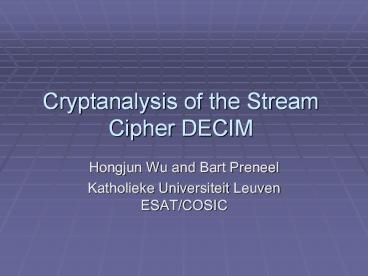Cryptanalysis of the Stream Cipher DECIM - PowerPoint PPT Presentation
Title:
Cryptanalysis of the Stream Cipher DECIM
Description:
Cryptanalysis of the Stream Cipher DECIM. Hongjun Wu and Bart Preneel ... (similar to the self-shrinking generator, 25% more efficient) 2. Buffer for constant ... – PowerPoint PPT presentation
Number of Views:143
Avg rating:3.0/5.0
Title: Cryptanalysis of the Stream Cipher DECIM
1
Cryptanalysis of the Stream Cipher DECIM
- Hongjun Wu and Bart Preneel
- Katholieke Universiteit Leuven ESAT/COSIC
2
Overview
- 1. Introduction to DECIM
- 2. Key Recovery Attack (on Initialization)
- 3. Distinguishing Attack
- 4. Conclusion
3
Description of DECIM (1)
- submission to the eStream
- 80-bit key, 64 or 80-bit IV
- hardware efficient stream cipher (profile II)
- Main features
- 1. ABSG decimation algorithm
- (similar to the self-shrinking generator,
25 more efficient) - 2. Buffer for constant output rate
4
Description of DECIM (2)
- Keystream generation
5
Description of DECIM (3)
- DECIM consists of
- 192-bit regularly clocked LFSR (14 taps)
- two filtering functions (different tap
positions) - ABSG decimation
- split the sequence into the form
- if i 0,output the bit b
otherwise, output the inverse of b - 32-bit Buffer
- for every 4/3 input bits, only one
output bit
6
Description of DECIM (4)
- Key/IV setup
- 192 steps
- each step -- the non-linear feedback
- a permutation on 7
LFSR bits
7
Key Recovery Attack (1)
- Overview of the Attack
- The permutations are used to update the
LFSR - gt 54.5 bits in the LFSR are not updated
during - the key/IV setup
- gt key recovered with 220 random IVs,
- the first 2 keystream bytes,
- negligible computations
8
Key Recovery Attack (2)
- Two permutations operate on 7 elements
- (st5, st31,st59,st100,st144,st177,s
t186) - If the output of ABSG is 1, the first permutation
- is used otherwise, the second is used
9
Key Recovery Attack (3)
- Using permutation to update FSR is bad
- If no permutation, then every bit in the
FSR - is updated once every 192 steps
- But with the permutation on the FSR, the
bit - positions are changed, some bits would be
updated - more than once while some bits not
updated! - gt no matter how to design the permutation
- the updating would not be uniform for
all the bits
10
Key Recovery Attack (4)
- The key-dependent selection of permutations does
not - hide the intrinsic weakness of the permutation
- gtin average 54.5 bits in the LFSR are not
updated
11
Key Recovery Attack (5)
- To recover the key, we need to trace each key bit
to see - how that key bit is updated during those 192
steps - in the initialization
- gt very tedious
- use computer program to trace those key
bits
12
Key Recovery Attack (6)
- One example recovering K21
- s21 K21 \/ IV21
- s21 is not updated and it becomes s1926 with
prob 1/27 - s1926 used in the generation of the first
keystream bit z0 - if s1926 is 0, then z00 with prob. 56/128
- if s1926 is 1, then z00 with prob. 72/128
- if K21 1, the distribution of z0 independent of
IV21 - if K21 0, the distribution of z0 affected by
IV21 - gt Being used to identify K21 with about 218.5
random IVs
13
Distinguishing Attack (1)
- Overview of the Attack
- The filtering functions are not 1-resilient
- ABSG could not hide the non-randomness
- gt any two adjacent bits are equal with
0.52-9 - message being recovered if encrypted
218 times
14
Distinguishing Attack (2)
- Bias from the filtering function
- If two inputs share one common bit, the two
outputs bits - are equal with prob. 65/128
15
Distinguishing Attack (3)
- Bias passing through the ABSG decimation and
buffer - Deal with the bits with relations not affected
significantly by - the ABSG decimation algorithm
- i.e., the bits with small distance
- For these three pairs of bits, passing through
the ABSG - decimation and buffer does not reduce the bias
too much - (about 8 to 32 times)
- But the analysis is too complicated (details
ignored here)
16
Distinguishing Attack (4)
- Any two adjacent keystream bits are equal with
- probability 0.52-9
- The bias is large enough for the broadcast attack
- If a message if encrypted by DECIM for 218 times,
then - the message could be recovered
17
DECIM v2
- Initialization
- Permutation removed
- 768 steps
- Keystream generation
- one LFSR one filtering function ABSG
buffer - 1-resillient filtering function
- Greatly simplified comparing to the original
version
18
Conclusion
- Using permutation to update FSR is undesirable
- Try to design Boolean function conservatively
- (high resilience, .)
19
- Thank you!
- Q A































